Organizational Management and Leadership Analysis: Stewart-Charles
VerifiedAdded on 2022/10/18
|22
|3894
|128
Report
AI Summary
This report provides an in-depth analysis of the organizational management of Stewart-Charles, a multinational car manufacturing company based in Singapore. The report begins with an executive summary, followed by an introduction that outlines the company's background, vision, mission, and strategies. It then delves into an explanation of two key leadership theories, the Great Man theory and the Trait theory, evaluating their application within the organization and their impact on departmental structures. Furthermore, the report assesses the performance management system, including motivation and reward aspects, such as Maslow's hierarchy of needs and Alderfer's ERG theory. Finally, it examines the communication processes employed within Stewart-Charles. The report concludes by summarizing the key findings and providing a list of references and appendices, including relevant figures and diagrams.
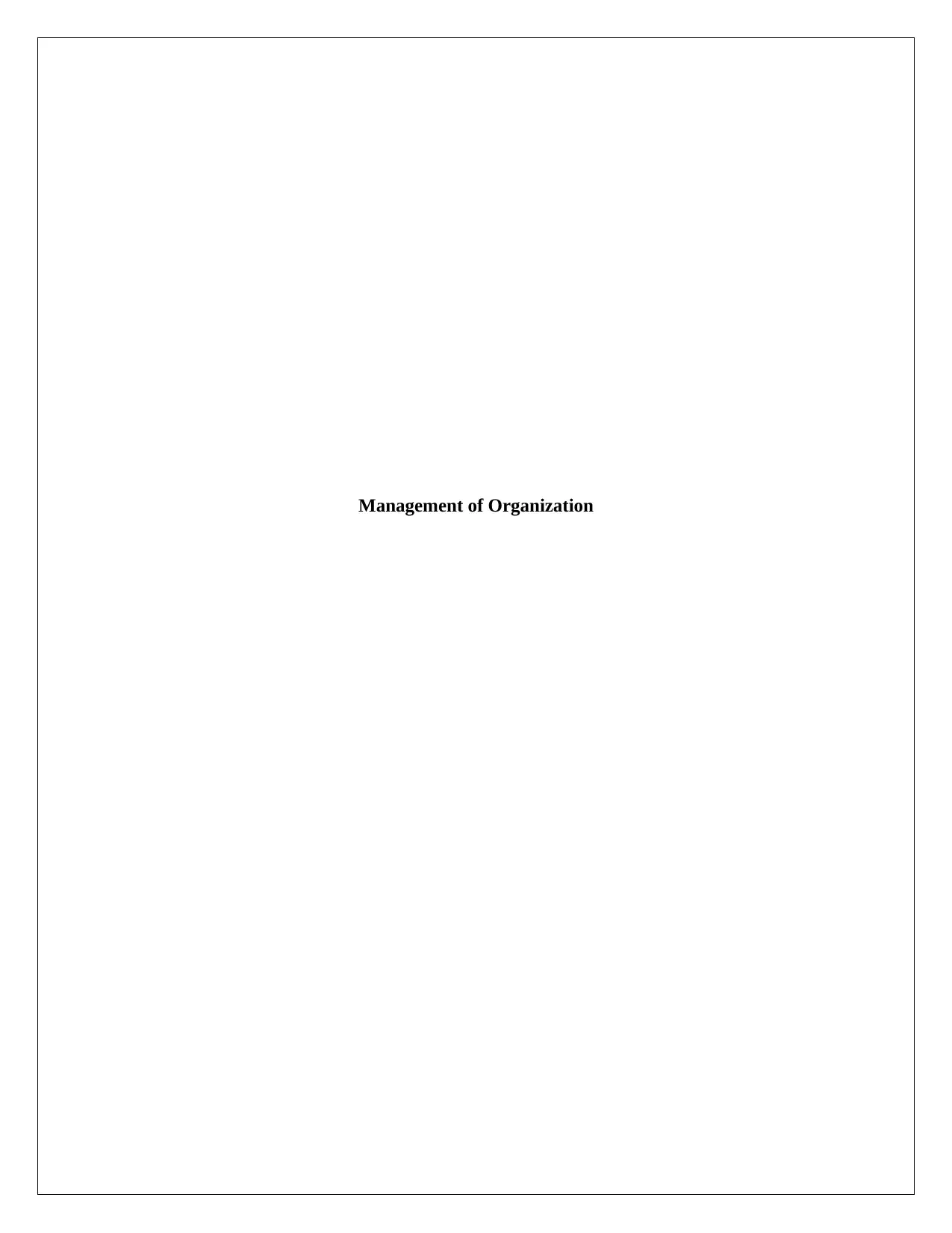
Management of Organization
Paraphrase This Document
Need a fresh take? Get an instant paraphrase of this document with our AI Paraphraser
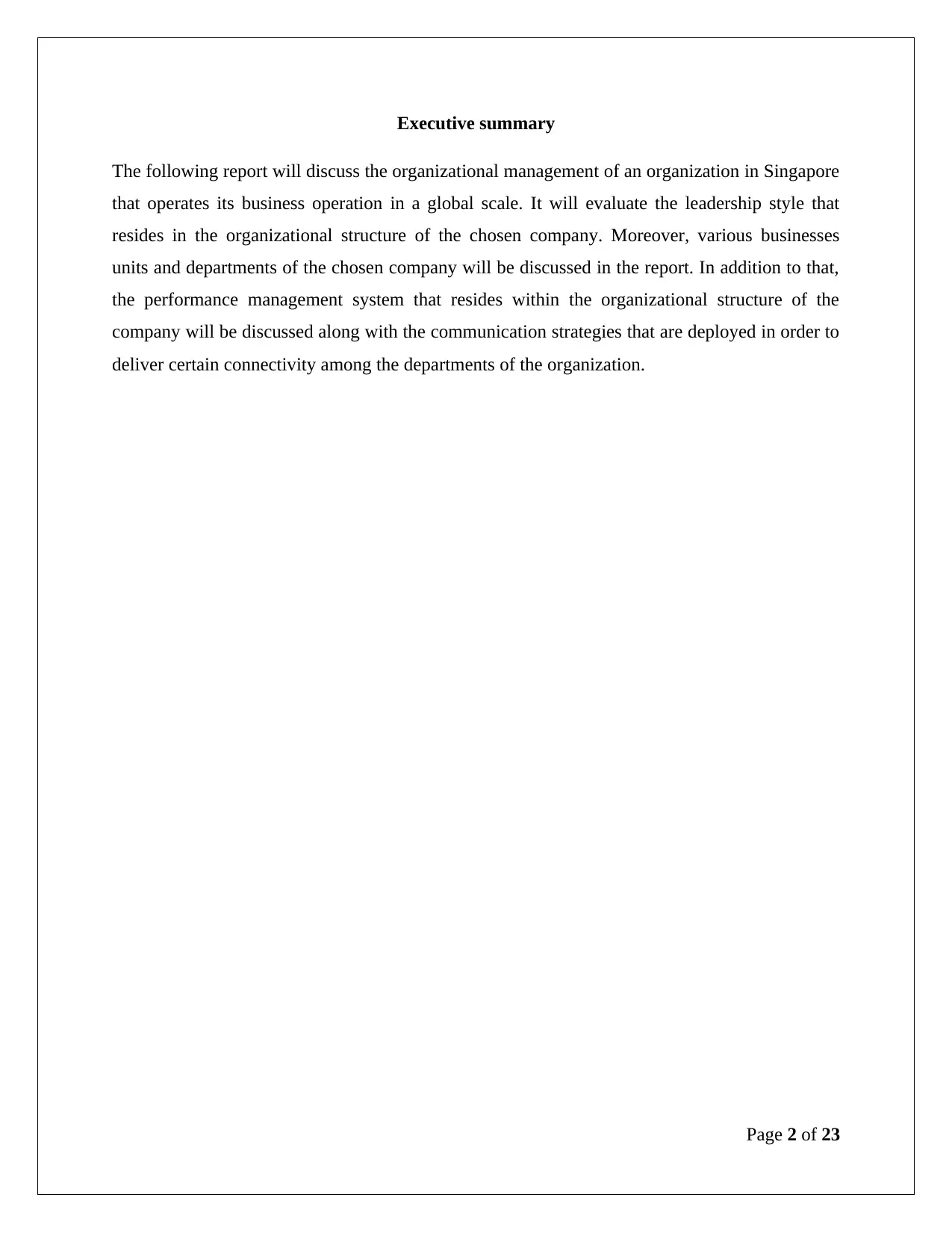
Executive summary
The following report will discuss the organizational management of an organization in Singapore
that operates its business operation in a global scale. It will evaluate the leadership style that
resides in the organizational structure of the chosen company. Moreover, various businesses
units and departments of the chosen company will be discussed in the report. In addition to that,
the performance management system that resides within the organizational structure of the
company will be discussed along with the communication strategies that are deployed in order to
deliver certain connectivity among the departments of the organization.
Page 2 of 23
The following report will discuss the organizational management of an organization in Singapore
that operates its business operation in a global scale. It will evaluate the leadership style that
resides in the organizational structure of the chosen company. Moreover, various businesses
units and departments of the chosen company will be discussed in the report. In addition to that,
the performance management system that resides within the organizational structure of the
company will be discussed along with the communication strategies that are deployed in order to
deliver certain connectivity among the departments of the organization.
Page 2 of 23
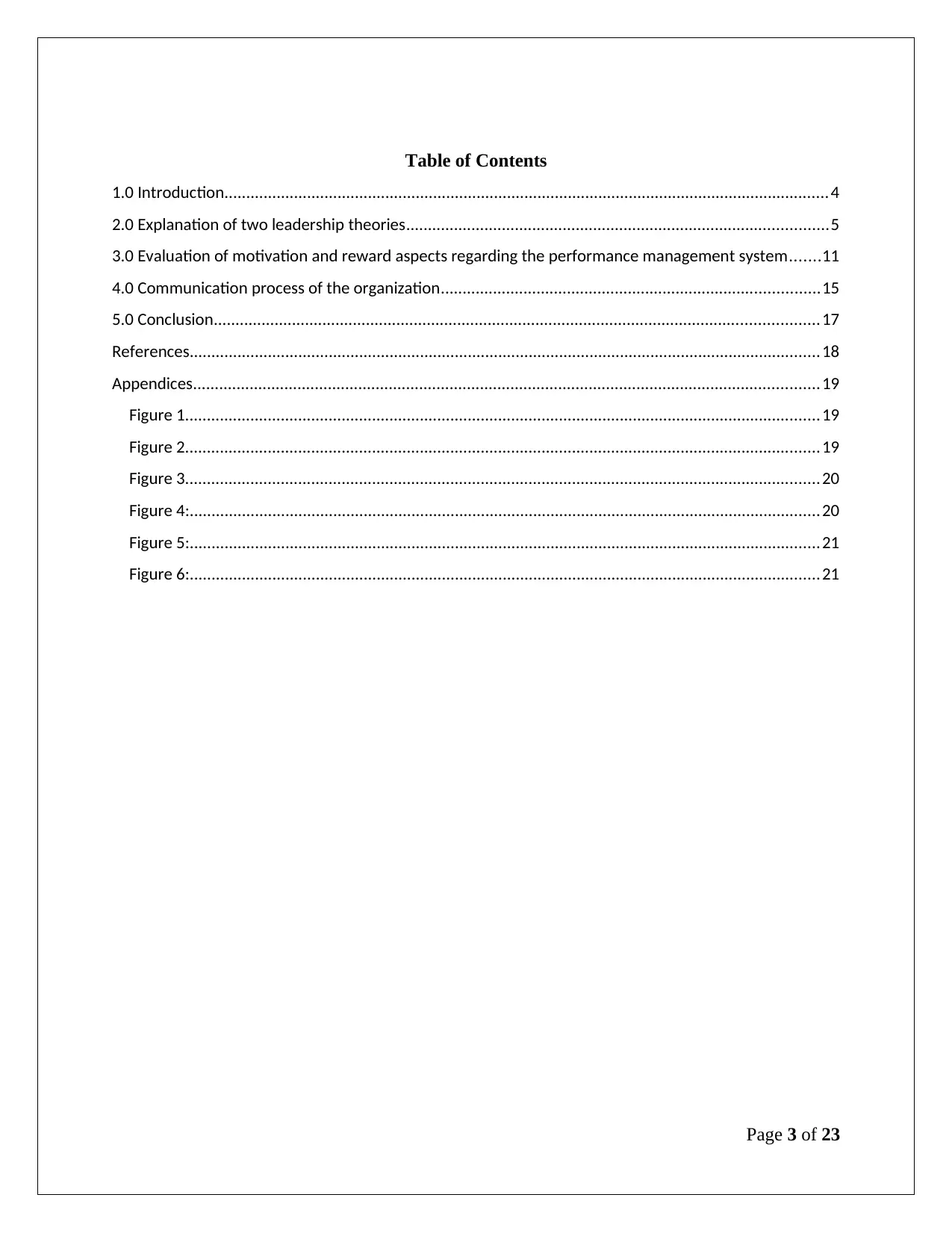
Table of Contents
1.0 Introduction...........................................................................................................................................4
2.0 Explanation of two leadership theories.................................................................................................5
3.0 Evaluation of motivation and reward aspects regarding the performance management system.......11
4.0 Communication process of the organization.......................................................................................15
5.0 Conclusion...........................................................................................................................................17
References.................................................................................................................................................18
Appendices................................................................................................................................................19
Figure 1..................................................................................................................................................19
Figure 2..................................................................................................................................................19
Figure 3..................................................................................................................................................20
Figure 4:.................................................................................................................................................20
Figure 5:.................................................................................................................................................21
Figure 6:.................................................................................................................................................21
Page 3 of 23
1.0 Introduction...........................................................................................................................................4
2.0 Explanation of two leadership theories.................................................................................................5
3.0 Evaluation of motivation and reward aspects regarding the performance management system.......11
4.0 Communication process of the organization.......................................................................................15
5.0 Conclusion...........................................................................................................................................17
References.................................................................................................................................................18
Appendices................................................................................................................................................19
Figure 1..................................................................................................................................................19
Figure 2..................................................................................................................................................19
Figure 3..................................................................................................................................................20
Figure 4:.................................................................................................................................................20
Figure 5:.................................................................................................................................................21
Figure 6:.................................................................................................................................................21
Page 3 of 23
⊘ This is a preview!⊘
Do you want full access?
Subscribe today to unlock all pages.

Trusted by 1+ million students worldwide
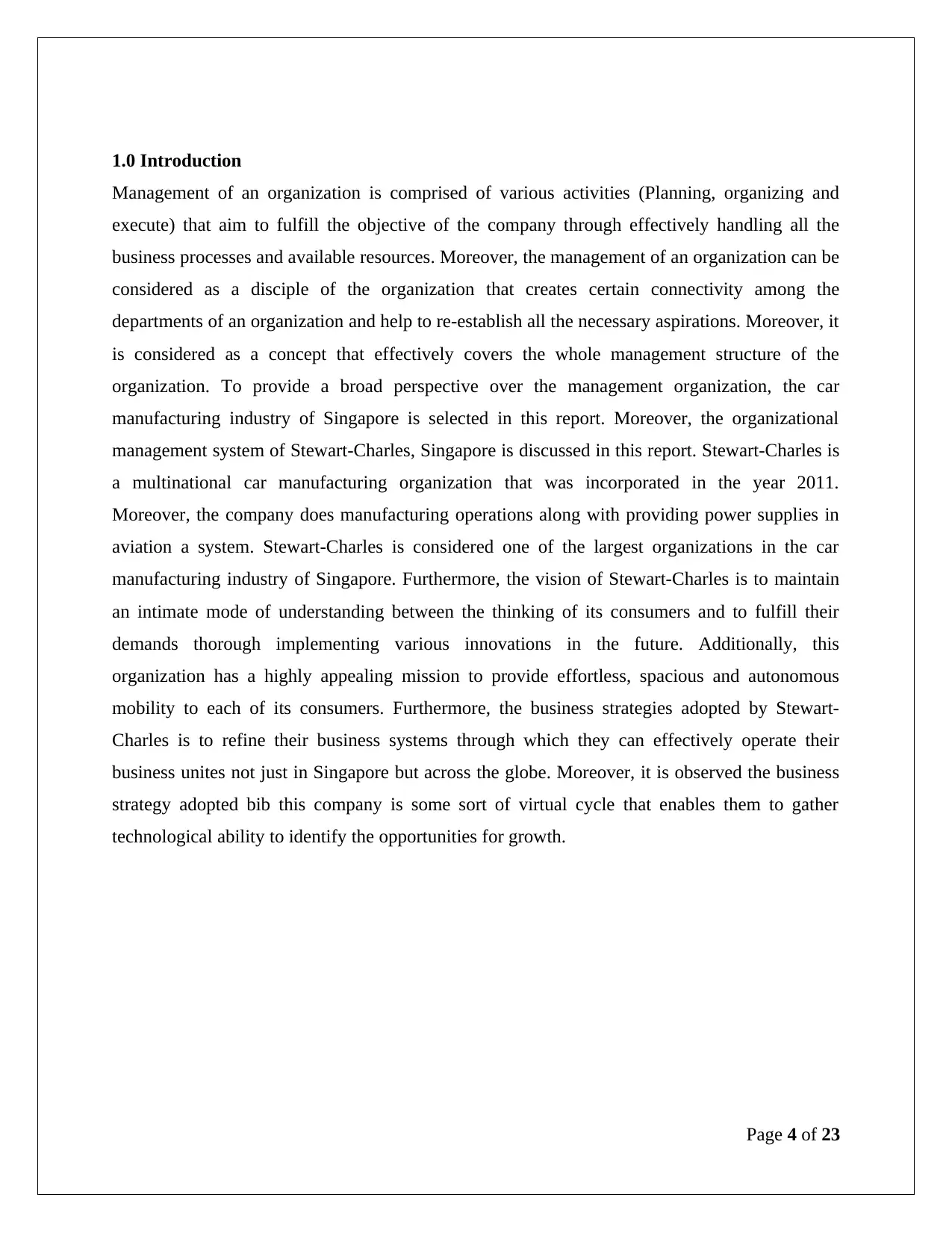
1.0 Introduction
Management of an organization is comprised of various activities (Planning, organizing and
execute) that aim to fulfill the objective of the company through effectively handling all the
business processes and available resources. Moreover, the management of an organization can be
considered as a disciple of the organization that creates certain connectivity among the
departments of an organization and help to re-establish all the necessary aspirations. Moreover, it
is considered as a concept that effectively covers the whole management structure of the
organization. To provide a broad perspective over the management organization, the car
manufacturing industry of Singapore is selected in this report. Moreover, the organizational
management system of Stewart-Charles, Singapore is discussed in this report. Stewart-Charles is
a multinational car manufacturing organization that was incorporated in the year 2011.
Moreover, the company does manufacturing operations along with providing power supplies in
aviation a system. Stewart-Charles is considered one of the largest organizations in the car
manufacturing industry of Singapore. Furthermore, the vision of Stewart-Charles is to maintain
an intimate mode of understanding between the thinking of its consumers and to fulfill their
demands thorough implementing various innovations in the future. Additionally, this
organization has a highly appealing mission to provide effortless, spacious and autonomous
mobility to each of its consumers. Furthermore, the business strategies adopted by Stewart-
Charles is to refine their business systems through which they can effectively operate their
business unites not just in Singapore but across the globe. Moreover, it is observed the business
strategy adopted bib this company is some sort of virtual cycle that enables them to gather
technological ability to identify the opportunities for growth.
Page 4 of 23
Management of an organization is comprised of various activities (Planning, organizing and
execute) that aim to fulfill the objective of the company through effectively handling all the
business processes and available resources. Moreover, the management of an organization can be
considered as a disciple of the organization that creates certain connectivity among the
departments of an organization and help to re-establish all the necessary aspirations. Moreover, it
is considered as a concept that effectively covers the whole management structure of the
organization. To provide a broad perspective over the management organization, the car
manufacturing industry of Singapore is selected in this report. Moreover, the organizational
management system of Stewart-Charles, Singapore is discussed in this report. Stewart-Charles is
a multinational car manufacturing organization that was incorporated in the year 2011.
Moreover, the company does manufacturing operations along with providing power supplies in
aviation a system. Stewart-Charles is considered one of the largest organizations in the car
manufacturing industry of Singapore. Furthermore, the vision of Stewart-Charles is to maintain
an intimate mode of understanding between the thinking of its consumers and to fulfill their
demands thorough implementing various innovations in the future. Additionally, this
organization has a highly appealing mission to provide effortless, spacious and autonomous
mobility to each of its consumers. Furthermore, the business strategies adopted by Stewart-
Charles is to refine their business systems through which they can effectively operate their
business unites not just in Singapore but across the globe. Moreover, it is observed the business
strategy adopted bib this company is some sort of virtual cycle that enables them to gather
technological ability to identify the opportunities for growth.
Page 4 of 23
Paraphrase This Document
Need a fresh take? Get an instant paraphrase of this document with our AI Paraphraser
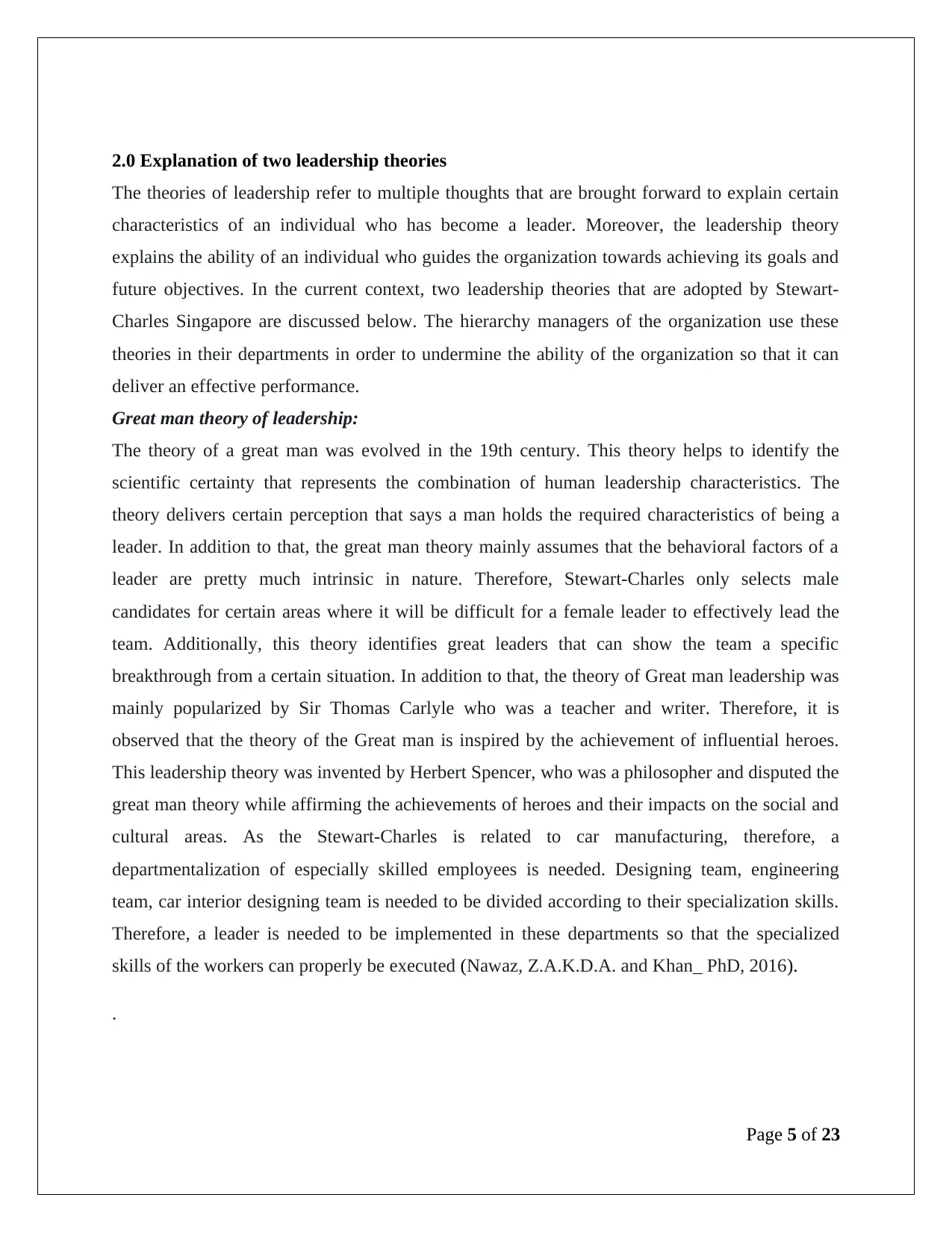
2.0 Explanation of two leadership theories
The theories of leadership refer to multiple thoughts that are brought forward to explain certain
characteristics of an individual who has become a leader. Moreover, the leadership theory
explains the ability of an individual who guides the organization towards achieving its goals and
future objectives. In the current context, two leadership theories that are adopted by Stewart-
Charles Singapore are discussed below. The hierarchy managers of the organization use these
theories in their departments in order to undermine the ability of the organization so that it can
deliver an effective performance.
Great man theory of leadership:
The theory of a great man was evolved in the 19th century. This theory helps to identify the
scientific certainty that represents the combination of human leadership characteristics. The
theory delivers certain perception that says a man holds the required characteristics of being a
leader. In addition to that, the great man theory mainly assumes that the behavioral factors of a
leader are pretty much intrinsic in nature. Therefore, Stewart-Charles only selects male
candidates for certain areas where it will be difficult for a female leader to effectively lead the
team. Additionally, this theory identifies great leaders that can show the team a specific
breakthrough from a certain situation. In addition to that, the theory of Great man leadership was
mainly popularized by Sir Thomas Carlyle who was a teacher and writer. Therefore, it is
observed that the theory of the Great man is inspired by the achievement of influential heroes.
This leadership theory was invented by Herbert Spencer, who was a philosopher and disputed the
great man theory while affirming the achievements of heroes and their impacts on the social and
cultural areas. As the Stewart-Charles is related to car manufacturing, therefore, a
departmentalization of especially skilled employees is needed. Designing team, engineering
team, car interior designing team is needed to be divided according to their specialization skills.
Therefore, a leader is needed to be implemented in these departments so that the specialized
skills of the workers can properly be executed (Nawaz, Z.A.K.D.A. and Khan_ PhD, 2016).
.
Page 5 of 23
The theories of leadership refer to multiple thoughts that are brought forward to explain certain
characteristics of an individual who has become a leader. Moreover, the leadership theory
explains the ability of an individual who guides the organization towards achieving its goals and
future objectives. In the current context, two leadership theories that are adopted by Stewart-
Charles Singapore are discussed below. The hierarchy managers of the organization use these
theories in their departments in order to undermine the ability of the organization so that it can
deliver an effective performance.
Great man theory of leadership:
The theory of a great man was evolved in the 19th century. This theory helps to identify the
scientific certainty that represents the combination of human leadership characteristics. The
theory delivers certain perception that says a man holds the required characteristics of being a
leader. In addition to that, the great man theory mainly assumes that the behavioral factors of a
leader are pretty much intrinsic in nature. Therefore, Stewart-Charles only selects male
candidates for certain areas where it will be difficult for a female leader to effectively lead the
team. Additionally, this theory identifies great leaders that can show the team a specific
breakthrough from a certain situation. In addition to that, the theory of Great man leadership was
mainly popularized by Sir Thomas Carlyle who was a teacher and writer. Therefore, it is
observed that the theory of the Great man is inspired by the achievement of influential heroes.
This leadership theory was invented by Herbert Spencer, who was a philosopher and disputed the
great man theory while affirming the achievements of heroes and their impacts on the social and
cultural areas. As the Stewart-Charles is related to car manufacturing, therefore, a
departmentalization of especially skilled employees is needed. Designing team, engineering
team, car interior designing team is needed to be divided according to their specialization skills.
Therefore, a leader is needed to be implemented in these departments so that the specialized
skills of the workers can properly be executed (Nawaz, Z.A.K.D.A. and Khan_ PhD, 2016).
.
Page 5 of 23
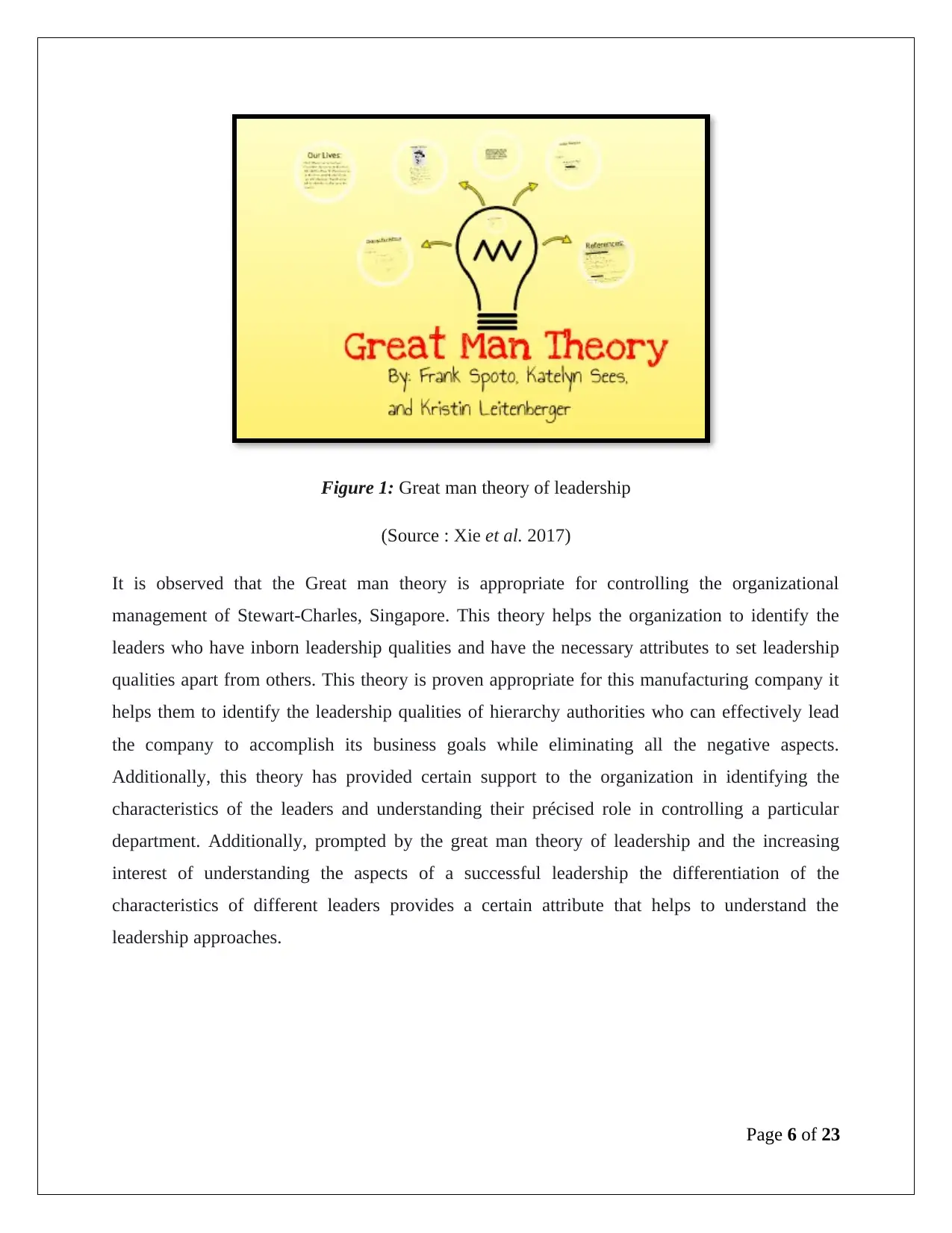
Figure 1: Great man theory of leadership
(Source : Xie et al. 2017)
It is observed that the Great man theory is appropriate for controlling the organizational
management of Stewart-Charles, Singapore. This theory helps the organization to identify the
leaders who have inborn leadership qualities and have the necessary attributes to set leadership
qualities apart from others. This theory is proven appropriate for this manufacturing company it
helps them to identify the leadership qualities of hierarchy authorities who can effectively lead
the company to accomplish its business goals while eliminating all the negative aspects.
Additionally, this theory has provided certain support to the organization in identifying the
characteristics of the leaders and understanding their précised role in controlling a particular
department. Additionally, prompted by the great man theory of leadership and the increasing
interest of understanding the aspects of a successful leadership the differentiation of the
characteristics of different leaders provides a certain attribute that helps to understand the
leadership approaches.
Page 6 of 23
(Source : Xie et al. 2017)
It is observed that the Great man theory is appropriate for controlling the organizational
management of Stewart-Charles, Singapore. This theory helps the organization to identify the
leaders who have inborn leadership qualities and have the necessary attributes to set leadership
qualities apart from others. This theory is proven appropriate for this manufacturing company it
helps them to identify the leadership qualities of hierarchy authorities who can effectively lead
the company to accomplish its business goals while eliminating all the negative aspects.
Additionally, this theory has provided certain support to the organization in identifying the
characteristics of the leaders and understanding their précised role in controlling a particular
department. Additionally, prompted by the great man theory of leadership and the increasing
interest of understanding the aspects of a successful leadership the differentiation of the
characteristics of different leaders provides a certain attribute that helps to understand the
leadership approaches.
Page 6 of 23
⊘ This is a preview!⊘
Do you want full access?
Subscribe today to unlock all pages.

Trusted by 1+ million students worldwide
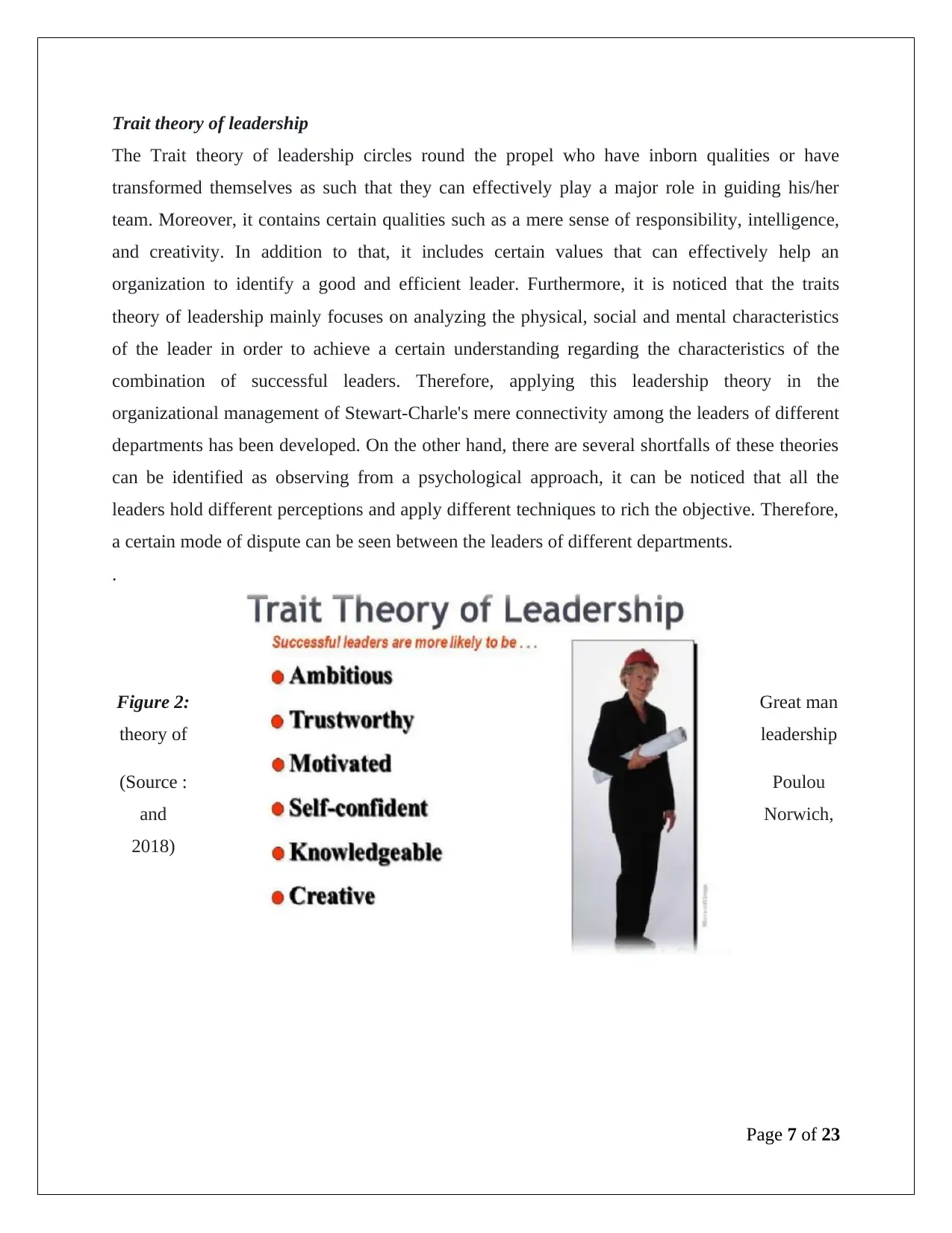
Trait theory of leadership
The Trait theory of leadership circles round the propel who have inborn qualities or have
transformed themselves as such that they can effectively play a major role in guiding his/her
team. Moreover, it contains certain qualities such as a mere sense of responsibility, intelligence,
and creativity. In addition to that, it includes certain values that can effectively help an
organization to identify a good and efficient leader. Furthermore, it is noticed that the traits
theory of leadership mainly focuses on analyzing the physical, social and mental characteristics
of the leader in order to achieve a certain understanding regarding the characteristics of the
combination of successful leaders. Therefore, applying this leadership theory in the
organizational management of Stewart-Charle's mere connectivity among the leaders of different
departments has been developed. On the other hand, there are several shortfalls of these theories
can be identified as observing from a psychological approach, it can be noticed that all the
leaders hold different perceptions and apply different techniques to rich the objective. Therefore,
a certain mode of dispute can be seen between the leaders of different departments.
.
Figure 2: Great man
theory of leadership
(Source : Poulou
and Norwich,
2018)
Page 7 of 23
The Trait theory of leadership circles round the propel who have inborn qualities or have
transformed themselves as such that they can effectively play a major role in guiding his/her
team. Moreover, it contains certain qualities such as a mere sense of responsibility, intelligence,
and creativity. In addition to that, it includes certain values that can effectively help an
organization to identify a good and efficient leader. Furthermore, it is noticed that the traits
theory of leadership mainly focuses on analyzing the physical, social and mental characteristics
of the leader in order to achieve a certain understanding regarding the characteristics of the
combination of successful leaders. Therefore, applying this leadership theory in the
organizational management of Stewart-Charle's mere connectivity among the leaders of different
departments has been developed. On the other hand, there are several shortfalls of these theories
can be identified as observing from a psychological approach, it can be noticed that all the
leaders hold different perceptions and apply different techniques to rich the objective. Therefore,
a certain mode of dispute can be seen between the leaders of different departments.
.
Figure 2: Great man
theory of leadership
(Source : Poulou
and Norwich,
2018)
Page 7 of 23
Paraphrase This Document
Need a fresh take? Get an instant paraphrase of this document with our AI Paraphraser
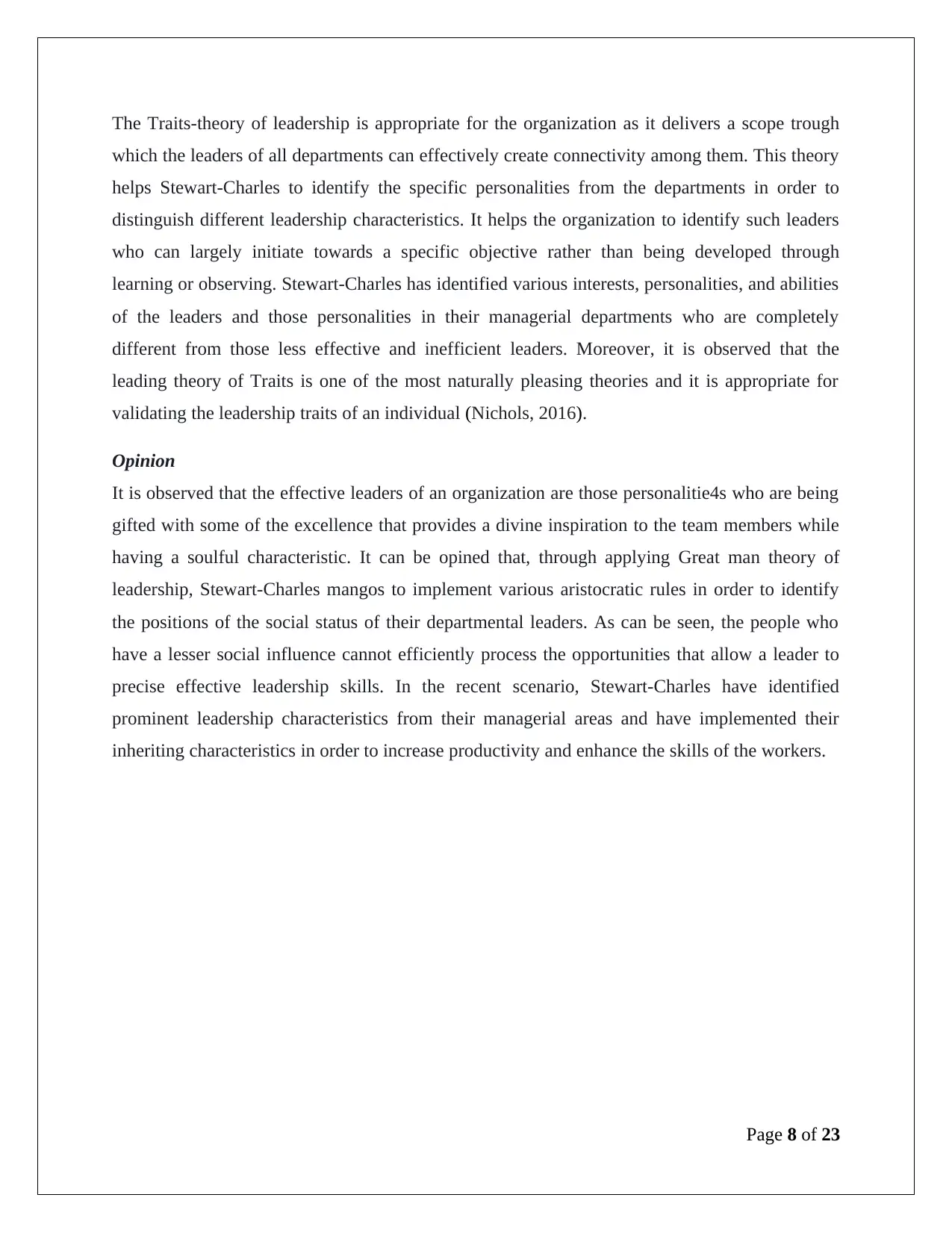
The Traits-theory of leadership is appropriate for the organization as it delivers a scope trough
which the leaders of all departments can effectively create connectivity among them. This theory
helps Stewart-Charles to identify the specific personalities from the departments in order to
distinguish different leadership characteristics. It helps the organization to identify such leaders
who can largely initiate towards a specific objective rather than being developed through
learning or observing. Stewart-Charles has identified various interests, personalities, and abilities
of the leaders and those personalities in their managerial departments who are completely
different from those less effective and inefficient leaders. Moreover, it is observed that the
leading theory of Traits is one of the most naturally pleasing theories and it is appropriate for
validating the leadership traits of an individual (Nichols, 2016).
Opinion
It is observed that the effective leaders of an organization are those personalitie4s who are being
gifted with some of the excellence that provides a divine inspiration to the team members while
having a soulful characteristic. It can be opined that, through applying Great man theory of
leadership, Stewart-Charles mangos to implement various aristocratic rules in order to identify
the positions of the social status of their departmental leaders. As can be seen, the people who
have a lesser social influence cannot efficiently process the opportunities that allow a leader to
precise effective leadership skills. In the recent scenario, Stewart-Charles have identified
prominent leadership characteristics from their managerial areas and have implemented their
inheriting characteristics in order to increase productivity and enhance the skills of the workers.
Page 8 of 23
which the leaders of all departments can effectively create connectivity among them. This theory
helps Stewart-Charles to identify the specific personalities from the departments in order to
distinguish different leadership characteristics. It helps the organization to identify such leaders
who can largely initiate towards a specific objective rather than being developed through
learning or observing. Stewart-Charles has identified various interests, personalities, and abilities
of the leaders and those personalities in their managerial departments who are completely
different from those less effective and inefficient leaders. Moreover, it is observed that the
leading theory of Traits is one of the most naturally pleasing theories and it is appropriate for
validating the leadership traits of an individual (Nichols, 2016).
Opinion
It is observed that the effective leaders of an organization are those personalitie4s who are being
gifted with some of the excellence that provides a divine inspiration to the team members while
having a soulful characteristic. It can be opined that, through applying Great man theory of
leadership, Stewart-Charles mangos to implement various aristocratic rules in order to identify
the positions of the social status of their departmental leaders. As can be seen, the people who
have a lesser social influence cannot efficiently process the opportunities that allow a leader to
precise effective leadership skills. In the recent scenario, Stewart-Charles have identified
prominent leadership characteristics from their managerial areas and have implemented their
inheriting characteristics in order to increase productivity and enhance the skills of the workers.
Page 8 of 23
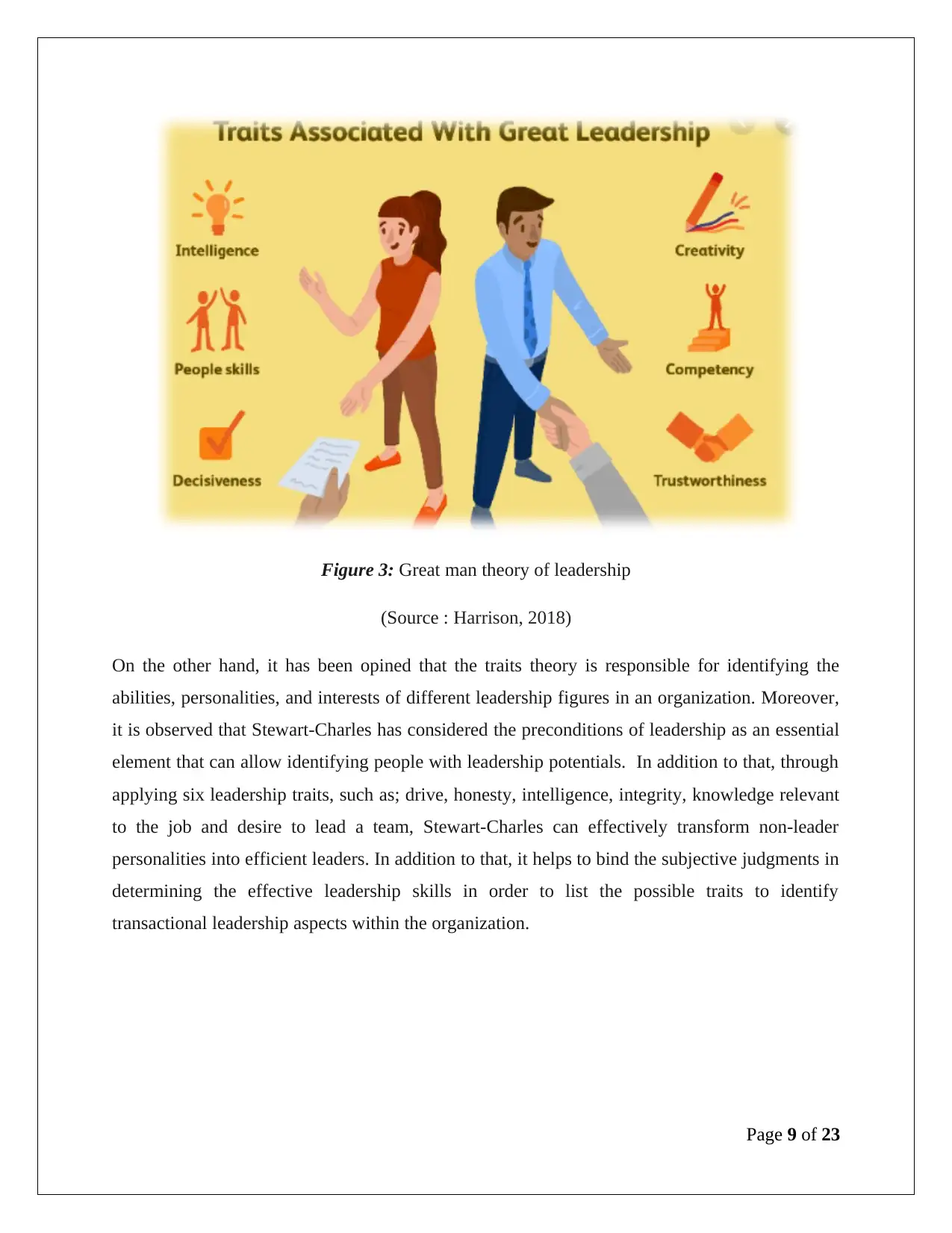
Figure 3: Great man theory of leadership
(Source : Harrison, 2018)
On the other hand, it has been opined that the traits theory is responsible for identifying the
abilities, personalities, and interests of different leadership figures in an organization. Moreover,
it is observed that Stewart-Charles has considered the preconditions of leadership as an essential
element that can allow identifying people with leadership potentials. In addition to that, through
applying six leadership traits, such as; drive, honesty, intelligence, integrity, knowledge relevant
to the job and desire to lead a team, Stewart-Charles can effectively transform non-leader
personalities into efficient leaders. In addition to that, it helps to bind the subjective judgments in
determining the effective leadership skills in order to list the possible traits to identify
transactional leadership aspects within the organization.
Page 9 of 23
(Source : Harrison, 2018)
On the other hand, it has been opined that the traits theory is responsible for identifying the
abilities, personalities, and interests of different leadership figures in an organization. Moreover,
it is observed that Stewart-Charles has considered the preconditions of leadership as an essential
element that can allow identifying people with leadership potentials. In addition to that, through
applying six leadership traits, such as; drive, honesty, intelligence, integrity, knowledge relevant
to the job and desire to lead a team, Stewart-Charles can effectively transform non-leader
personalities into efficient leaders. In addition to that, it helps to bind the subjective judgments in
determining the effective leadership skills in order to list the possible traits to identify
transactional leadership aspects within the organization.
Page 9 of 23
⊘ This is a preview!⊘
Do you want full access?
Subscribe today to unlock all pages.

Trusted by 1+ million students worldwide
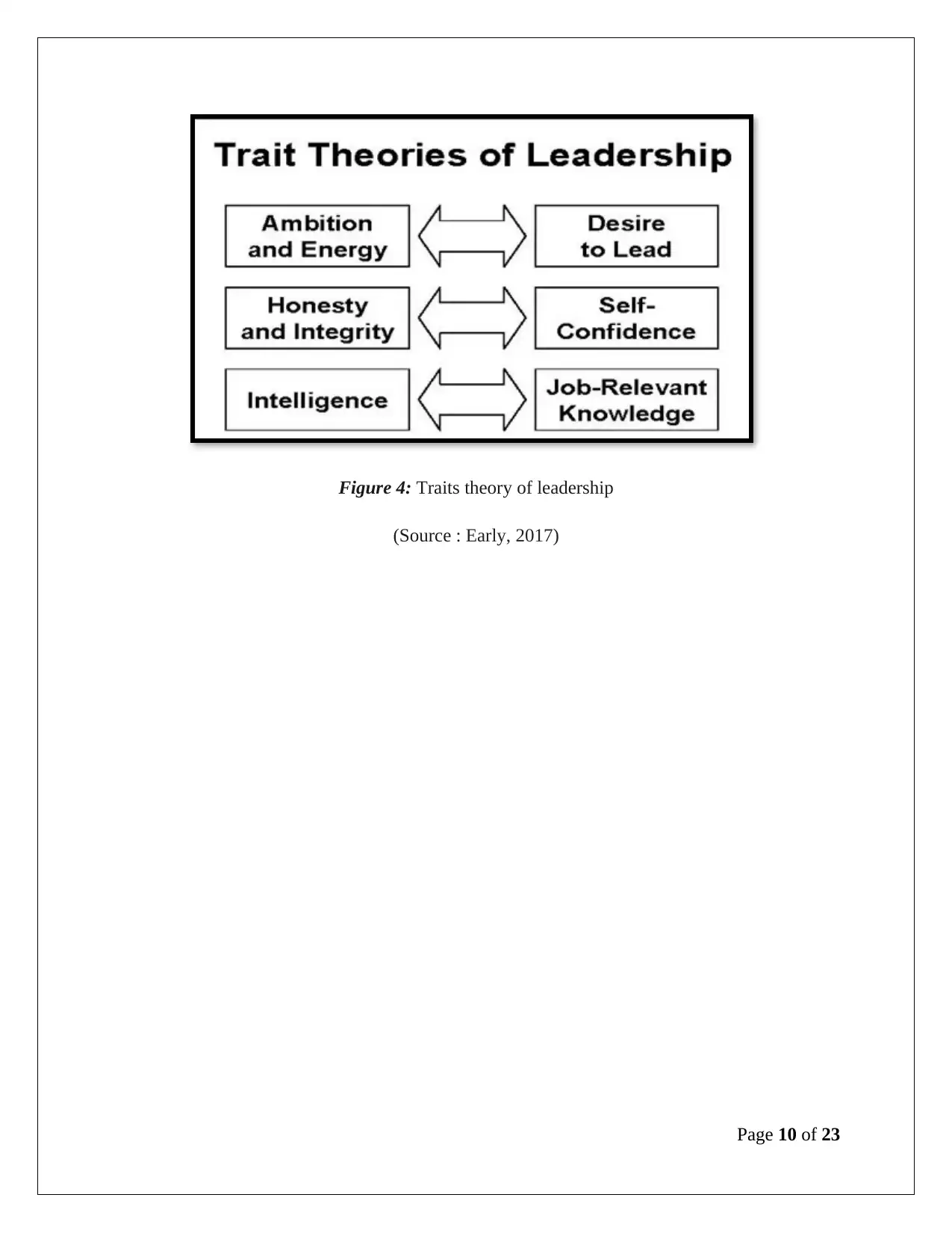
Figure 4: Traits theory of leadership
(Source : Early, 2017)
Page 10 of 23
(Source : Early, 2017)
Page 10 of 23
Paraphrase This Document
Need a fresh take? Get an instant paraphrase of this document with our AI Paraphraser
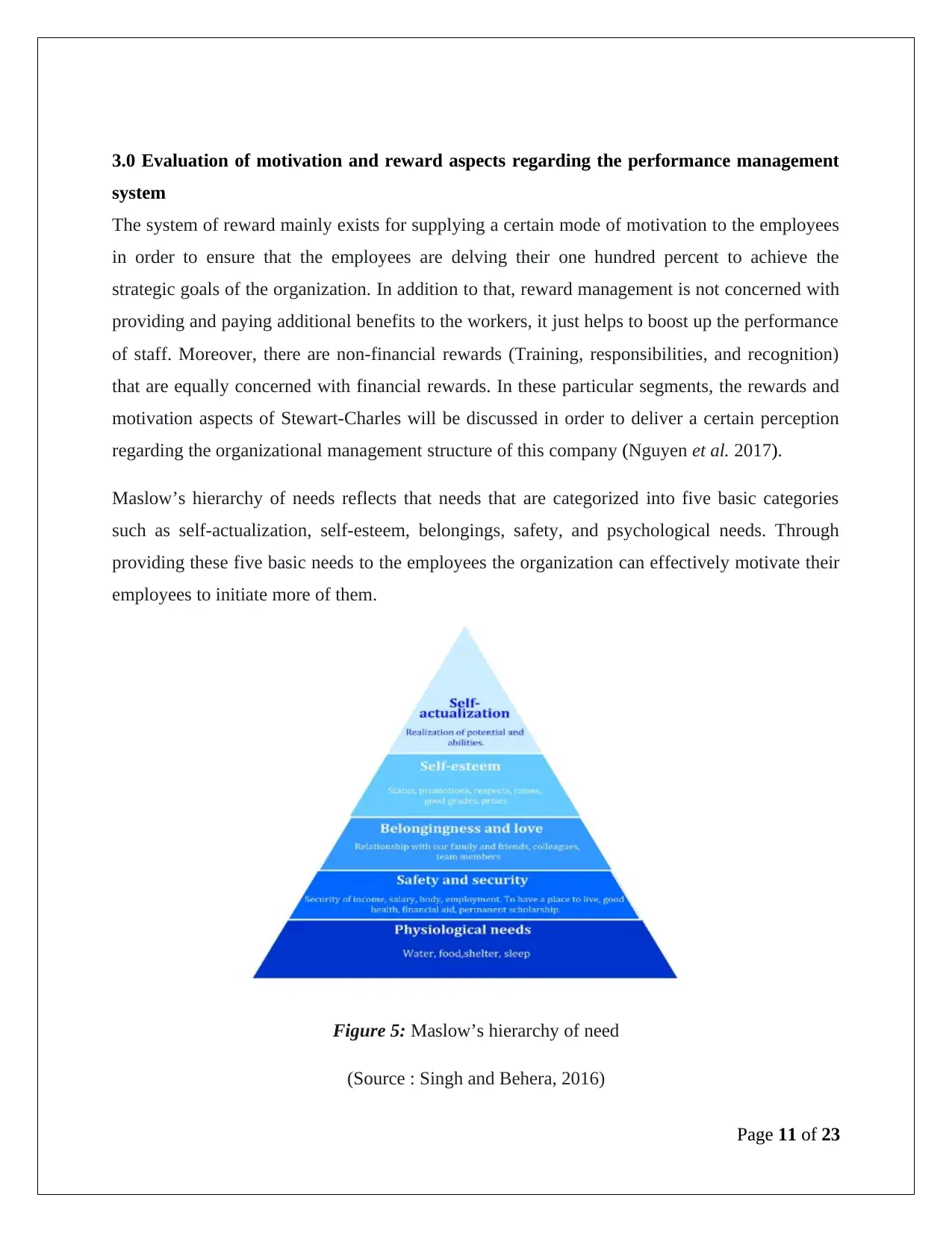
3.0 Evaluation of motivation and reward aspects regarding the performance management
system
The system of reward mainly exists for supplying a certain mode of motivation to the employees
in order to ensure that the employees are delving their one hundred percent to achieve the
strategic goals of the organization. In addition to that, reward management is not concerned with
providing and paying additional benefits to the workers, it just helps to boost up the performance
of staff. Moreover, there are non-financial rewards (Training, responsibilities, and recognition)
that are equally concerned with financial rewards. In these particular segments, the rewards and
motivation aspects of Stewart-Charles will be discussed in order to deliver a certain perception
regarding the organizational management structure of this company (Nguyen et al. 2017).
Maslow’s hierarchy of needs reflects that needs that are categorized into five basic categories
such as self-actualization, self-esteem, belongings, safety, and psychological needs. Through
providing these five basic needs to the employees the organization can effectively motivate their
employees to initiate more of them.
Figure 5: Maslow’s hierarchy of need
(Source : Singh and Behera, 2016)
Page 11 of 23
system
The system of reward mainly exists for supplying a certain mode of motivation to the employees
in order to ensure that the employees are delving their one hundred percent to achieve the
strategic goals of the organization. In addition to that, reward management is not concerned with
providing and paying additional benefits to the workers, it just helps to boost up the performance
of staff. Moreover, there are non-financial rewards (Training, responsibilities, and recognition)
that are equally concerned with financial rewards. In these particular segments, the rewards and
motivation aspects of Stewart-Charles will be discussed in order to deliver a certain perception
regarding the organizational management structure of this company (Nguyen et al. 2017).
Maslow’s hierarchy of needs reflects that needs that are categorized into five basic categories
such as self-actualization, self-esteem, belongings, safety, and psychological needs. Through
providing these five basic needs to the employees the organization can effectively motivate their
employees to initiate more of them.
Figure 5: Maslow’s hierarchy of need
(Source : Singh and Behera, 2016)
Page 11 of 23
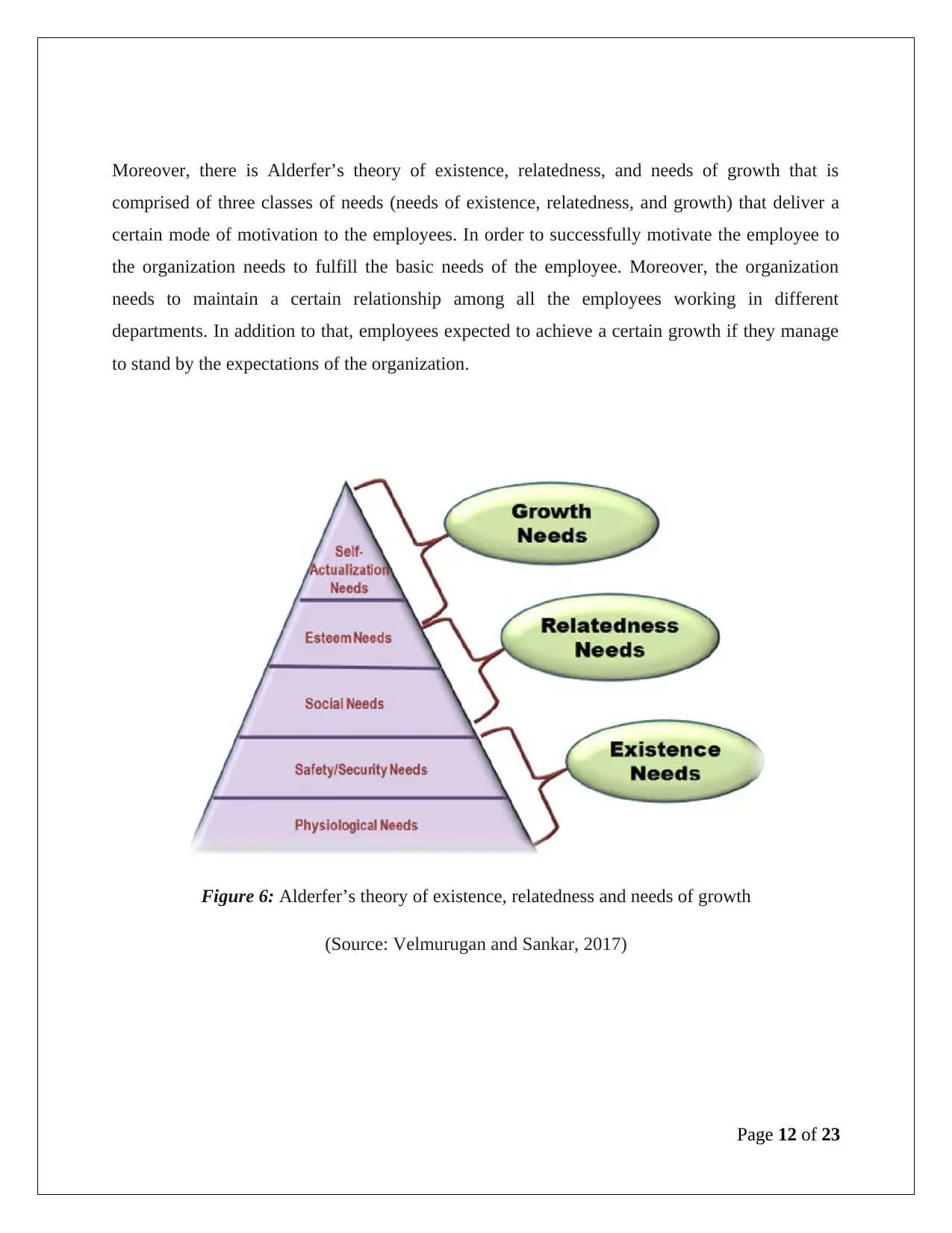
Moreover, there is Alderfer’s theory of existence, relatedness, and needs of growth that is
comprised of three classes of needs (needs of existence, relatedness, and growth) that deliver a
certain mode of motivation to the employees. In order to successfully motivate the employee to
the organization needs to fulfill the basic needs of the employee. Moreover, the organization
needs to maintain a certain relationship among all the employees working in different
departments. In addition to that, employees expected to achieve a certain growth if they manage
to stand by the expectations of the organization.
Figure 6: Alderfer’s theory of existence, relatedness and needs of growth
(Source: Velmurugan and Sankar, 2017)
Page 12 of 23
comprised of three classes of needs (needs of existence, relatedness, and growth) that deliver a
certain mode of motivation to the employees. In order to successfully motivate the employee to
the organization needs to fulfill the basic needs of the employee. Moreover, the organization
needs to maintain a certain relationship among all the employees working in different
departments. In addition to that, employees expected to achieve a certain growth if they manage
to stand by the expectations of the organization.
Figure 6: Alderfer’s theory of existence, relatedness and needs of growth
(Source: Velmurugan and Sankar, 2017)
Page 12 of 23
⊘ This is a preview!⊘
Do you want full access?
Subscribe today to unlock all pages.

Trusted by 1+ million students worldwide
1 out of 22
Related Documents
Your All-in-One AI-Powered Toolkit for Academic Success.
+13062052269
info@desklib.com
Available 24*7 on WhatsApp / Email
![[object Object]](/_next/static/media/star-bottom.7253800d.svg)
Unlock your academic potential
Copyright © 2020–2025 A2Z Services. All Rights Reserved. Developed and managed by ZUCOL.





